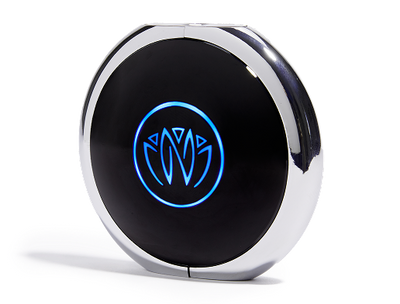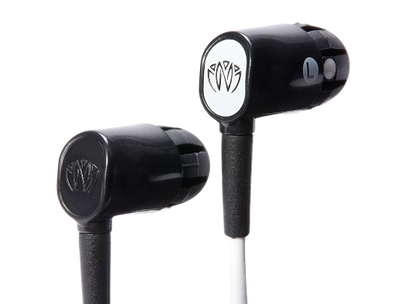All of the nerves in your body play their own vital roles. But when it comes to the vagus nerve, it may just be one of the most powerful nerves of them all—at least when it comes to healing your body and keeping it healthy as you age. Today, we'll talk more about the healing power of the vagus nerve and how it can benefit your mental and physical health as you age. We’ll also discuss the benefits of vagus nerve stimulation (VNS) and the incredible role these benefits can play as we age.
The vagus nerve is a long, wandering nerve that runs from the brainstem all the way down to the abdomen. It's sometimes referred to as the "wandering nerve" because of its meandering path through the body. This nerve is essential for a number of different functions, including:
- Regulating heart rate
- Controlling blood pressure
- Aiding in digestion
- Boosting immunity
- Promoting healthy inflammation response
Because of its many roles in the body, stimulating the vagus nerve has been shown to have several healing benefits.
How the Vagus Nerve Impacts Mental and Physical Health
Before we explore the specific healing benefits of vagus nerve stimulation, let's first take a look at how this nerve impacts our mental and physical health.
As we mentioned, the vagus nerve is responsible for regulating many important functions in the body. For example, when this nerve is functioning properly, it helps keep the body in a state of balance or homeostasis. But when something goes wrong with the vagus nerve—such as when it becomes damaged or inflamed—it can lead to certain (and often serious) health problems.
Some of the most common problems associated with an impaired vagus nerve include:
- High blood pressure: The vagus nerve helps regulate blood pressure by controlling the constriction and dilation of blood vessels. When the vagus nerve isn't functioning at its peak, it can cause blood vessels to constrict too much, leading to high blood pressure.
- Heart arrhythmias: The vagus nerve also helps regulate heart rate. When this nerve is damaged or impaired, it can cause heart arrhythmias or irregular heartbeats.
- Digestive problems: The vagus nerve is responsible for aiding digestion by stimulating the digestive tract muscles. If this nerve is not functioning properly, it can lead to problems like constipation, diarrhea, bloating, and nausea.
- Autoimmune diseases: The vagus nerve plays a role in immunity by helping to regulate the inflammatory response. When this nerve is impaired, it can lead to chronic inflammation and an increased risk for autoimmune diseases.
As you can see, an impaired vagus nerve can seriously impact your mental and physical health. But fortunately, there are things you can do to stimulate this important nerve and help promote healing in the body.
Before we talk about how to stimulate the vagus nerve, we'll first look at some of the healing benefits associated with this therapy. Interestingly, many of the conditions vagus nerve stimulation can benefit are associated with aging. So, although a healthy vagus nerve is important at all ages, it can be particularly important as we age.
Lower blood pressure

One of the most exciting potential healing benefits of vagus nerve stimulation is its ability to lower blood pressure. This is because vagus nerve stimulation helps to regulate the constriction and dilation of blood vessels, as we mentioned. So that means it may have the ability to both lower blood pressure when it's too high and increase blood pressure when it's too low.
Lower heart rate
Vagus nerve stimulation has also been shown to lower heart rate and play a role in heart rate variability. This is because the vagus nerve helps regulate heart rate by controlling the nerves that stimulate the heart muscle.
Increase immunity
The vagus nerve also plays a role in immunity because of how it can regulate the body’s inflammatory response. Because of this, vagus nerve stimulation has the potential to increase immunity by helping to reduce chronic inflammation associated with many illnesses.
How To Access The Healing Power of the Vagus Nerve
Now, let's talk more about tapping into this healing power to experience the benefits for yourself as you age.
If you want to dive even deeper into this subject, we encourage you to order a copy of Accessing the Healing Power of the Vagus Nerve: Self-Help Exercises for Anxiety, Depression, Trauma, and Autism by Stanley Rosenberg.
In the meantime, we'll cover five powerful ways to stimulate the vagus nerve: eating healthy foods, SKY Yoga, breathing exercises, three-part breathing, and cold water immersion.
Healthy foods

To understand how a healthy diet can support the vagus nerve, we must first discuss the gut-brain axis and what the vagus nerve has to do with it.
The gut-brain axis is the two-way communication highway between the gut and the brain. This system includes the nervous system, hormones, and the immune system. The vagus nerve is a key player in this system because it runs from the brain to the digestive tract.
Now, you may be wondering how this gut-brain connection can impact the health of the vagus nerve (and vice versa). Well, studies show that the gut microbiota (the trillions of bacteria that live in the gut) can influence the vagus nerve. As such, a healthy gut microbiome is essential for a healthy vagus nerve.
In fact, a 2014 study found people with conditions such as irritable bowel syndrome (IBS) or Crohn's disease often have reduced vagal nerve tone and vagus nerve activity.
This highlights the importance of eating a healthy diet rich in probiotics and prebiotics and why it's one of the best things you can do for the vagus nerve. Probiotics are live bacteria that support gut health, and prebiotics are the food that these probiotics need to thrive. Some good sources of prebiotics include chicory root, dandelion greens, garlic, Jerusalem artichoke, and onions.
In addition to probiotics and prebiotics, it's also important to eat plenty of anti-inflammatory foods. These include omega-3 fatty acids, turmeric, ginger, bone broth, and fermented vegetables. Eating these types of foods will help reduce inflammation in the body and support the health of the vagus nerve.
Now that we've covered some of the best foods for the vagus nerve, let's move on to another powerful way to stimulate this vital nerve: SKY Yoga.
SKY Yogas
SKY Yoga or Sudarshan Kriya Yoga is a type of yoga that can powerfully stimulate the vagus nerve, providing several other benefits. This is done through a combination of breathwork, chanting, and specific mudras (hand gestures).
A study published in Frontiers in Psychology found that just eight weeks of SKY Yoga was enough to increase vagal tone in many people significantly:
"Controlled studies have found yoga-based interventions to be effective in treating depression ranging from mild depressive symptoms to major depressive disorder (MDD) (136). Some yoga practices can directly stimulate the vagus nerve, by increasing the vagal tone leading to an improvement of autonomic regulation, cognitive functions, and mood (137) and stress coping (138). The proposed neurophysiological mechanisms for the success of yoga-based therapies in alleviating depressive symptoms suggest that yoga breathing induces increased vagal tone (139).
Many studies demonstrate the effects of yogic breathing on brain function and physiologic parameters. Thus, Sudarshan Kriya Yoga (SKY), a breathing-based meditative technique, stimulates the vagus nerve and exerts numerous autonomic effects, including changes in heart rate, improved cognition, and improved bowel function (140).
During SKY, a sequence of breathing techniques of different frequencies, intensities, lengths, and with end-inspiratory and end-expiratory holds creates varied stimuli from multiple visceral afferents, sensory receptors, and baroreceptors. These probably influence diverse vagal fibers, which in turn induce physiologic changes in organs, and influence the limbic system (140). A recent study showed that even patients who did not respond to antidepressants showed a significant reduction of depressive and anxiety symptoms compared to the control group after receiving an adjunctive intervention with SKY for 8 weeks (141)."
To experience the benefits of SKY Yoga for yourself, we recommend checking out a SKY Yoga class or workshop. Alternatively, you can also find SKY Yoga videos online that you can do in the comfort of your own home.
Breathing exercises
One of the simplest, most accessible ways to stimulate the vagus nerve is just by breathing! That's right—something as simple as taking some deep breaths can profoundly impact your vagus nerve and overall health.
There are a few different breathing exercises that you can do to stimulate the vagus nerve. One of our favorites is Wim Hof Breathing, which is a type of deep breathing named after Dutch "Iceman" Wim Hof. This breathing exercise is said to help improve focus, boost energy levels, and reduce stress and anxiety.
As is explained on the Wim Hof Method website:
"You can indirectly stimulate the vagus nerve by taking deep, deliberate breaths from your belly. Deep breathing activates specific neurons that detect blood pressure. These neurons signal to the vagus nerve that blood pressure is becoming too high, and the vagus nerve in turn responds by lowering your heart rate."
Three-part breathing
On the subject of breathing exercises, it's also worth mentioning three-part breathing (aka dirga pranayama in Sanskrit). Three-part breathing is a type of pranayama, which is a type of breathing exercise that originates from the yogic tradition.
To try it for yourself, lie down on your back with your eyes closed or sit comfortably if you prefer.
Place one hand on your belly and the other on your chest. Start by taking a deep breath through your nose, filling your belly first and then your chest. Then exhale slowly and completely through your nose, deflating your belly first and then your chest. Continue this pattern of breath for at least 10 breaths. You'll find more detailed instructions here.
Cold water immersion

Although cold plunges have recently become more mainstream, the practice of using cold water for healing actually dates back thousands of years.
Nowadays, people are using ice baths and cold showers as a way to stimulate the vagus nerve, reduce inflammation, and improve circulation. There is even some evidence to suggest that cold water immersion can help improve mood and reduce anxiety.
To experience the healing power of the vagus nerve for yourself, try taking a cold shower or bath. Start with 1-2 minutes of exposure. Then, work your way up to more extended periods of time as you become more comfortable.
You can also try ice baths. Fill a tub with cold water and add a few bags of ice. Submerge yourself in the tub for 1-2 minutes, or as long as you can tolerate.
If you're lucky enough to live near a body of water suitable for swimming, take a dip in the lake, ocean, or river. The colder, the better!
Other Benefits of Vagus Nerve Stimulation
Along with the vagus nerve's healing power, several other benefits have been associated with vagus nerve stimulation.
Let's talk about those next, including exploring some we've already mentioned in greater detail.
Improved mental health symptoms

When the vagus nerve is stimulated, it can increase the release of neurotransmitters like serotonin and dopamine. These hormones are responsible for regulating mood, so it's no surprise that stimulating the vagus nerve can lead to a brighter mood.
In one study, people with depression who underwent electrical stimulation of the vagus nerve reported a decrease in psychiatric and inflammatory disorders symptoms.
Similarly, in a 2001 study, people with treatment-resistant depression who underwent vagus nerve stimulation therapy significantly reduced symptoms compared to those who did not receive therapy.
Reduced inflammation
Inflammation is a natural process that occurs in the body when it's fighting off infection or injury. However, chronic inflammation can lead to serious health problems, including heart disease and cancer.
Vagus nerve stimulation has been shown to lower levels of inflammatory markers in the body, suggesting that it may be a valuable treatment for chronic inflammation.
In one study, people with rheumatoid arthritis who underwent vagus nerve stimulation therapy had a decrease in levels of the inflammatory marker TNF-alpha.
In another study, people with Crohn's disease who underwent vagus nerve stimulation therapy had a decrease in levels of the inflammatory markers CRP and ESR.
Improved heart health
Vagus nerve stimulation has also been shown to improve heart health.
The heart and the vagus nerve are intimately connected, so it's no surprise that stimulating the vagus nerve can positively impact heart health.
One promising study on people with heart failure who underwent vagus nerve stimulation therapy finds:
"Experimental data have demonstrated that stimulation of the vagus nerve is able to reverse ventricular remodeling of the failing heart. There is also evidence that increasing parasympathetic activity may stimulate the production of nitric oxide and reduce the devastating inflammatory process involved in HF."
According to another study on people with heart failure, researchers found that those who underwent vagus nerve stimulation therapy significantly improved left ventricular ejection fraction (LVEF).
LVEF is a measure of how well the heart is pumping blood. A decrease in LVEF is a common symptom of heart failure.
So, these studies suggest that vagus nerve stimulation may be a promising treatment for heart failure.
Improved cognitive function
Cognitive function refers to the ability to think, learn, and remember, and one of the most exciting potential benefits of vagus nerve stimulation is its ability to improve these skills.
When the vagus nerve is stimulated, it can, in turn, boost neuroplasticity. This is the brain's ability to adapt and change in response to new stimuli. This connection comes from the vagus nerve sending signals to the brain that can impact cognitive function.
One study on rats found that those who underwent vagus nerve stimulation increased the growth of new neurons in the hippocampus (the brain region responsible for learning and memory).
We often don't think much about cognitive function until we begin to notice a decline as we’re aging. So, it's exciting to think that stimulating the vagus nerve may be a way to prevent or even reverse cognitive decline.
Reduced symptoms of migraines and cluster headaches

Migraines and cluster headaches are two types of headaches that can be extremely debilitating.
Strong evidence suggests that vagus nerve stimulation may be a helpful treatment for migraines and cluster headaches. In fact, VNS is an FDA-cleared treatment for just that!
According to one study on people with migraines, researchers found that those who underwent vagus nerve stimulation therapy significantly reduced the number of days they experienced migraines.
In this 2016 study on people with cluster headaches, researchers found that those who underwent vagus nerve stimulation therapy significantly reduced the severity and frequency of their headaches.
So, if you suffer from migraines or cluster headaches, vagus nerve stimulation may be worth considering.
Better sleep quality
Sleep is one of the most important things for our overall health and well-being. But unfortunately, many of us don't get enough quality sleep. The vagus nerve can help with that.
When the vagus nerve is stimulated, it sends signals to the brain that promote relaxation and sleep. That's why exercises that stimulate the vagus nerve (like deep breathing or meditation) can effectively improve sleep quality.
Experience the Healing Power of the Vagus Nerve with Xen by Neuvana
If you're interested in trying vagus nerve stimulation for yourself to promote healthy aging and healing, Xen by Neuvana is a great place to start!
The Xen vagus nerve stimulation device by Neuvana is a non-invasive wearable device that sends electrical signals to the vagus nerve, providing all of the potential benefits we've discussed here. Xen comprises vagus nerve stimulating headphones that connect to a handheld device you'll sync to your phone. With the Neuvana app, you can customize your experience by choosing your sessions' intensity, duration, and frequency. You can also select your favorite music or sounds to listen to while your vagus nerve is stimulated through the ear.
You can use Xen for as little or as long as you like, and the results are cumulative, meaning they build over time!
Xen by Neuvana is safe, easy to use, and clinically proven to be effective. So, if you're looking for a way to experience the healing power of the vagus nerve, give it a try today!





